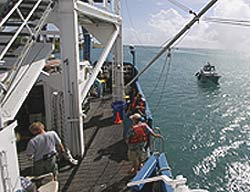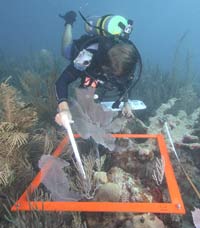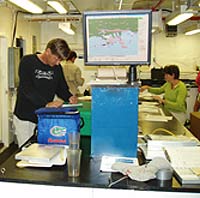On Board the OSV BOLD: Transition
Posted on February 24th, 2009 - 2:00 PM| For more than a month, EPA’s Ocean Survey Vessel (OSV) Bold is studying the health of the waters around Puerto Rico and the U.S. Virgin Islands. EPA scientists and non-scientists will blog about their research and what it’s like to live and work at sea. |
About the author: Charles LoBue serves as the chief scientist and diver for the US Virgin Island leg of the OSV BOLD voyage. He is an environmental scientist in EPA Region 2 in New York City.
Feb. 23, 2009 - 3:00 pm (Day 15)
As the Puerto Rico leg of the OSV BOLD’s survey winds down, the U.S. Virgin Islands leg is beginning. We’re staffed, equipped and ready to begin a nearly three-week survey to assess the condition of coral reefs around St. Thomas and St. John. We’ve reassembled this experienced team of divers and scientists to resume the work that began in 2006. Back then, EPA worked with V.I. Department of Planning and Natural Resources (DPNR) in St. Croix to initiate an inventive new coral monitoring program developed by EPA’s Office of Research and Development. Our team will include divers from EPA, DPNR, U.S. Fish and Wildlife Service, and The Nature Conservancy.
The waters that we are working in this year are new to us, which adds an element of adventure. Our plan is to perform strategic observations and measurements of corals and other biota at 60 stations around the islands. Water and sediment sampling will add to the mix. Each morning, we will assign dive teams to three small boats, which will be dispatched to different observation stations.
 Here’s the basic process once we’re in the water. When a dive team arrives at a station, a snorkel reconnaissance is performed to assess whether the site has suitable coral cover. The team then enters the water and lays a 25-meter transect line to mark the domain of the observations. The team then makes a general assessment of the cover types, measures topography, counts other invertebrate species, and collects sediment and water samples throughout the transect area. Coral experts will identify every hard coral colony encountered within a meter of the transect line, measure its dimensions, and judge how much of it is thriving.
Here’s the basic process once we’re in the water. When a dive team arrives at a station, a snorkel reconnaissance is performed to assess whether the site has suitable coral cover. The team then enters the water and lays a 25-meter transect line to mark the domain of the observations. The team then makes a general assessment of the cover types, measures topography, counts other invertebrate species, and collects sediment and water samples throughout the transect area. Coral experts will identify every hard coral colony encountered within a meter of the transect line, measure its dimensions, and judge how much of it is thriving.
 When the team returns to the OSV BOLD, data are entered into a computer for analyses and water samples are processed. This will go on for the duration of the survey.
When the team returns to the OSV BOLD, data are entered into a computer for analyses and water samples are processed. This will go on for the duration of the survey.
Sure it may seem to be a cookie-cutter process, but the best laid plans are always at the mercy of the weather and sea condition. Of course, underlying all this field work is the logistics and procedures needed to maintain to safe diving operations. Our challenge is to find and assess 60 suitable stations over some 50 some-odd miles of coast around the two islands and assorted cays. So here’s to blue skies, calm seas, and healthy coral.
Tags: BOLD Research Vessel, Virgin Islands
| Permalink | TrackBack
February 24th, 2009 at 9:29 pm
Stabilized VSAT is right telecommunication technology to support communication on the ship like this vessel.
Regards,
Hebrink
[Reply]
March 1st, 2009 at 7:53 am
We hope you come to Coral Bay, St. John on this trip — and let us know in advance so we can help you find suitable stations — as well as interact with the residents here. We have a $300,000 EPA CARE grant to protect the environment for humans and coral and the benthic habitat. Publicity with your ship would be a great asset for both our EPA programs. Please contact us. Thanks
[Reply]